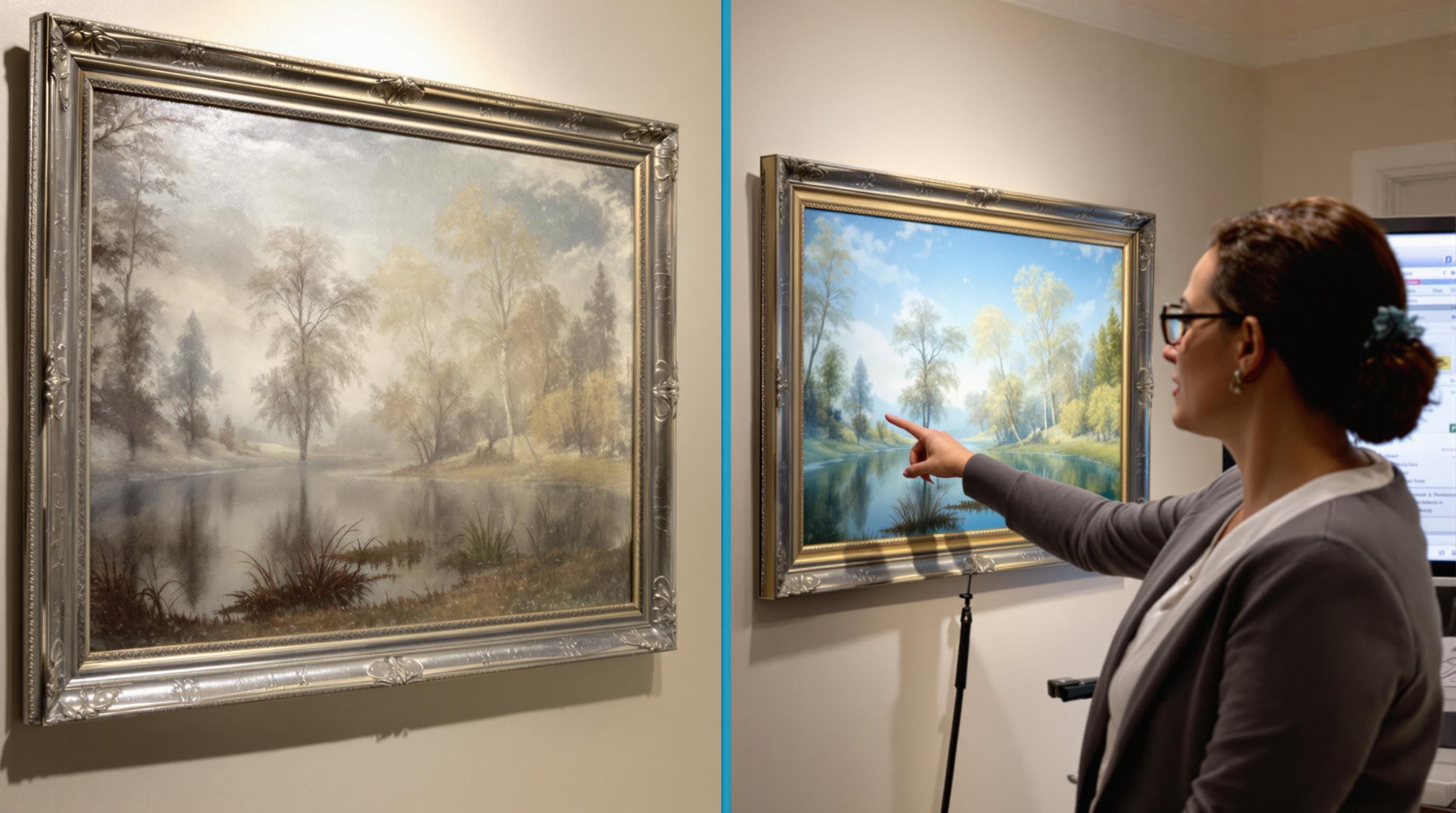Introduction to Fine Art Appraisals
When you possess a valuable piece of art, whether inherited, purchased, or discovered, knowing its true value becomes essential. Finding a qualified “fine art appraiser near me” is the crucial first step toward understanding your artwork’s worth. Professional art appraisals provide documented valuations necessary for insurance, estate planning, donations, sales, or simply satisfying your curiosity.
This comprehensive guide will help you locate reputable fine art appraisers in your area, understand the appraisal process, determine costs, and ensure you receive an accurate valuation that meets your specific needs.
Why You Need a Professional Fine Art Appraiser
Art appraisals serve multiple purposes, and understanding why you need one will help determine the type of appraisal required:
- Insurance Coverage: Documenting value to ensure adequate protection
- Estate Planning and Taxes: Establishing fair market value for estate distribution or tax purposes
- Charitable Donations: Substantiating value for tax deduction claims
- Sales and Purchases: Determining appropriate pricing for buying or selling artwork
- Divorce Settlements: Equitable division of art assets
- Authentication: Verifying authenticity and provenance
- Collection Management: Creating comprehensive inventories with valuations
Many people underestimate the importance of professional art appraisals until facing significant financial consequences from inaccurate or missing valuations. Homeowner’s insurance typically provides limited coverage for art unless specifically scheduled, making proper appraisals essential.
Fine Art Appraisal Market Facts
Finding Qualified Art Appraisers in Your Area
Professional Art Appraiser Directories
The most reliable method for finding certified appraisers is through professional association directories:
Appraisers Association of America (AAA): Maintains a searchable directory of certified appraisers by location and specialization. AAA members adhere to strict ethical standards and continuing education requirements.
International Society of Appraisers (ISA): Offers a comprehensive database of qualified appraisers. Their directory allows you to search by specialty, location, and the type of appraisal needed.
American Society of Appraisers (ASA): Features accredited members specializing in various art categories including fine art, decorative art, and antiques.
Local Art Appraisal Resources
Beyond national directories, explore these local options:
Museums and Art Galleries: Many institutions maintain lists of recommended appraisers or may have staff who perform appraisals.
Auction Houses: Major auction houses like Sotheby’s, Christie’s, and regional houses often provide appraisal services or can recommend independent appraisers.
Art Schools and Universities: Art departments at academic institutions may have faculty who perform appraisals or can suggest qualified professionals.
Online Review Platforms: Check Yelp or Google reviews for local art appraisers, but verify credentials independently.
Local Art Associations: Community art organizations often maintain relationships with trusted appraisers.
Essential Appraiser Credential Checklist
Use this checklist to verify appraiser qualifications
- Membership in professional appraisal organizations (AAA, ISA, ASA)
- Specialized education or certification in your type of artwork
- Complies with Uniform Standards of Professional Appraisal Practice (USPAP)
- Experience with your specific art medium or period
- No conflicts of interest (doesn't buy or sell art they appraise)
- References from previous clients or institutions
- Clear, written fee structure
Types of Fine Art Appraisals
Insurance Appraisals
Insurance appraisals determine the replacement value of artwork in case of loss, damage, or theft. These appraisals typically reflect retail replacement costs at current market prices, often higher than fair market values.
Fair Market Value Appraisals
Fair Market Value (FMV) appraisals establish what a willing buyer would pay a willing seller when neither is under pressure. These are commonly used for:
- Estate planning and inheritance taxes
- Charitable donations
- Divorce settlements
- Internal Revenue Service (IRS) requirements
Liquidation Value Appraisals
Liquidation appraisals determine the value when artwork must be sold quickly. These values are typically lower than fair market values and are used for:
- Bankruptcy proceedings
- Estate liquidations
- Forced sales
Authentication Appraisals
Authentication appraisals focus primarily on determining if a work is genuine, sometimes including attribution to a specific artist, period, or workshop. These often involve:
- Provenance research
- Technical analysis
- Expert connoisseurship
- Scientific testing when appropriate
The Art Appraisal Process
Initial Consultation
The appraisal process typically begins with an initial consultation where you’ll:
- Discuss your appraisal needs and intended use
- Provide basic information about your artwork
- Receive an estimate of fees and timeframe
- Schedule the actual appraisal inspection
Physical Examination
During the physical examination, the appraiser will:
- Inspect the artwork in person (crucial for accurate assessment)
- Document dimensions, media, techniques, and condition
- Photograph the artwork from multiple angles
- Note signatures, dates, inscriptions, and other identifying features
- Examine any labels, stamps, or markings on the back of the work
Research and Analysis
After the physical examination, appraisers conduct thorough research:
- Investigate provenance (ownership history)
- Research sales of comparable works
- Consult auction records and price databases
- Review literature and exhibition history
- Verify authenticity indicators
- Analyze market trends for similar works
Final Appraisal Report
The completed appraisal typically includes:
- Detailed description of the artwork
- High-quality photographs
- Statement of the valuation approach
- Explanation of the methodology used
- Supporting market data and comparable sales
- Final value determination
- Appraiser’s credentials and certification
- Statement of assumed conditions and limiting factors
Art Appraisal Fee Ranges
Typical costs for professional fine art appraisal services (2024)
</tbody>
</table>
Questions to Ask Before Hiring an Art Appraiser
What are your credentials and specializations? Verify their membership in professional organizations and experience with your type of artwork.
Are you USPAP compliant? The Uniform Standards of Professional Appraisal Practice set ethical and performance standards for appraisers.
Do you have experience appraising works similar to mine? An appraiser specializing in contemporary art may not be ideal for Renaissance paintings.
What is your fee structure? Understand whether they charge hourly, per item, or a flat fee, and get this in writing.
What information do you need from me beforehand? Prepare any provenance information, purchase receipts, certificates of authenticity, or other documentation.
What type of appraisal report will you provide? Confirm the report will meet your needs (insurance, donation, estate planning).
How long will the appraisal process take? Timelines can vary from days to weeks depending on complexity.
Do you maintain confidentiality? Ensure the appraiser will keep your information private.
Do you have errors and omissions insurance? Professional appraisers should carry insurance to protect against mistakes.
Can you provide references? Request names of previous clients, museums, or institutions they’ve worked with.

Preparing Your Artwork for Appraisal
Gather Documentation
Collect all relevant paperwork related to your artwork:
- Purchase receipts or bills of sale
- Previous appraisals or valuations
- Certificates of authenticity
- Exhibition history or museum loans
- Provenance documentation
- Conservation or restoration records
- Artist correspondence or statements
- Gallery labels or stickers
Prepare the Artwork
Ensure the appraiser can properly examine the piece:
- Clean glass or plexiglass coverings (but don’t clean the artwork itself)
- Remove from walls if necessary, but wait for appraiser’s guidance
- Make sure the work is accessible from all angles
- Ensure adequate lighting for proper examination
- Have a space prepared for the appraiser to work
Additional Information to Provide
- How and when you acquired the artwork
- Family history if the piece was inherited
- Any notable previous owners
- Known history of the work
- Your specific appraisal needs and timeline
Typical Fine Art Appraisal Timeline
- Day 1
Initial Contact
Contact appraiser, explain needs, arrange consultation - Day 7-14
Consultation & Inspection
Appraiser examines artwork, takes photographs, and notes details - Day 14-30
Research & Analysis
Appraiser researches comparable sales, provenance, and market conditions - Day 30-45
Report Preparation
Appraiser compiles findings, determines values, and prepares formal report - Day 45-60
Delivery & Review
Client receives report, reviews with appraiser, and addresses any questions
Online vs. In-Person Art Appraisals
In-Person Appraisals: Advantages
- Allow for detailed physical examination of materials, condition, and techniques
- Enable verification of signatures, markings, and other authentication elements
- Provide opportunity to assess size, scale, and three-dimensional aspects accurately
- Reveal condition issues that might not be visible in photographs
- Generally considered more accurate and comprehensive
Online Appraisals: Considerations
- More accessible for those in remote locations
- Often less expensive than in-person assessments
- Suitable for initial estimates or preliminary valuations
- Require high-quality photographs from multiple angles
- May miss crucial physical details that affect value
- Limited ability to assess condition accurately
- Not recommended for high-value items or authentication needs
For valuable artwork or pieces where authenticity may be questioned, an in-person appraisal is strongly recommended. Online appraisals are best used for:
- Preliminary estimates before deciding on a full appraisal
- Items of moderate value where condition is less critical
- Situations where geographic limitations prevent in-person assessment

Red Flags: When to Question an Art Appraiser
Be wary of appraisers who:
Offer to buy your artwork This represents a clear conflict of interest. Professional appraisers should not be dealers of works they appraise.
Guarantee values for insurance or tax purposes Legitimate appraisers provide objective opinions of value, not guaranteed outcomes.
Base fees on a percentage of the appraised value This creates incentive to inflate values inappropriately. Ethical appraisers charge based on time or flat rates.
Provide verbal-only appraisals Professional appraisals should always include written documentation.
Lack proper credentials or USPAP compliance Qualified appraisers maintain professional memberships and follow industry standards.
Refuse to explain methodology Transparent appraisers clearly explain how they arrived at their valuations.
Cannot provide references Established professionals should be able to provide client or institutional references.
Offer unusually low fees Quality appraisals require time and expertise; suspiciously low rates may indicate lack of thoroughness.
Claim expertise in everything Most legitimate appraisers specialize in specific periods, styles, or media.
Rush the process unnecessarily Thorough appraisals require careful examination and research.
Fine Art Appraisal Organizations & Resources
Appraisers Association of America
Searchable directory of certified appraisers specializing in fine art, antiques, and other collectibles, with options to find experts by location and specialty.
International Society of Appraisers
Comprehensive database of qualified personal property appraisers with advanced search options for finding specialists in various art forms.
Art Institute of Chicago: Appraisal Resources
Museum-curated guide to finding qualified art appraisers and understanding the appraisal process for fine art and antiques.
MIR Appraisal Services
Chicago-based fine art appraisal firm specializing in a wide range of artwork from Old Masters to Contemporary, antiques, and decorative items.
GB Fine Art Professional Appraisals
Chicago-area appraisal service offering valuation for insurance, estate planning, charitable donation, and other purposes throughout the Midwest.
The Art Dealers Association of America (ADAA)
Professional organization of leading art dealers offering appraisal services and maintaining standards for the art industry.
Lindsey Owen Appraisals
Professional appraisal service providing market analysis and data-driven valuations for fine art and antiques, along with comprehensive art advisory services.
American Society of Appraisers
Directory of accredited appraisers across multiple disciplines, including fine art, antiques, and other collectibles, with verification of member credentials.
After the Appraisal: Next Steps
Review the Appraisal Report
Carefully examine the completed appraisal document to ensure:
- All information about the artwork is accurate
- The valuation methodology is clearly explained
- Supporting evidence is included
- The intended use is correctly stated
- The appraiser’s qualifications are documented
Don’t hesitate to ask questions if anything is unclear or seems incorrect.
Update Insurance Coverage
If the appraisal was for insurance purposes:
- Contact your insurance provider promptly
- Provide a copy of the appraisal
- Update your policy to reflect the current value
- Discuss any special riders or fine art insurance needs
- Consider specialized fine art insurance for valuable pieces
Create Proper Documentation
Maintain comprehensive records for each appraised artwork:
- Store the appraisal in a secure location (physical and digital copies)
- Attach photographs of the artwork
- Include any certificates of authenticity
- Document provenance information
- Record conservation history
- Keep receipts of purchase or related expenses
Schedule Regular Reappraisals
Art markets fluctuate, and values change over time:
- Plan for reappraisals every 3-5 years
- Update more frequently for rapidly appreciating artists
- Reassess after significant market events
- Reappraise following conservation or restoration
- Document significant exhibition history that might affect value
Consider Collection Management
For multiple artworks:
- Create a detailed inventory system
- Digitize all appraisal documents
- Track insurance coverage for each piece
- Monitor market trends for your artists
- Consult with collection management professionals for larger collections
Common Questions About Fine Art Appraisals
How much does it cost to have a piece of art appraised?
Professional art appraisals typically cost between $125 and $350 per hour, with total costs varying based on the complexity of the artwork and the appraiser's expertise. For a single piece of art, you might expect to pay $250-$600 for a standard appraisal with a written report. More complex or high-value items can cost $600-$2,000+ to appraise.
Many appraisers will offer flat fee structures rather than hourly rates if requested. Collections of multiple pieces often receive discounted per-item rates. Initial consultations are frequently offered at no charge or at a reduced rate.
How can I get my artwork valued?
To have your artwork professionally valued:
- Determine your purpose for the appraisal (insurance, sale, donation, etc.)
- Find qualified appraisers through professional organizations like the Appraisers Association of America, International Society of Appraisers, or American Society of Appraisers
- Research the appraiser’s credentials and specialization in your type of artwork
- Gather documentation about your artwork (provenance, purchase records, certificates)
- Schedule an in-person examination whenever possible
- Receive a written appraisal report with the determined value and supporting analysis
For preliminary estimates, some auction houses, galleries, and online platforms offer free evaluations, but these are not substitutes for formal appraisals.
Is it worth getting art appraised?
Yes, professional art appraisal is worthwhile for several important reasons:
- Insurance purposes: Ensures adequate coverage for your artwork
- Estate planning: Establishes accurate values for inheritance and tax purposes
- Donations: Provides required documentation for charitable contribution deductions
- Sales decisions: Helps determine appropriate asking prices
- Authentication: Can verify legitimacy of questionable works
- Collection management: Creates valuable documentation of your holdings
The cost of an appraisal is typically minimal compared to the potential financial implications of inaccurate valuations, especially for insurance claims, tax liabilities, or when selling valuable pieces.
Can I get an art appraisal online?
Yes, online art appraisals are available, but they have significant limitations:
- Online appraisals rely on photographs and cannot detect physical characteristics that affect value (brushwork, canvas condition, paper quality, etc.)
- They’re generally considered preliminary estimates rather than formal appraisals
- Most online services cannot provide legally binding documents for insurance or tax purposes
- Authentication is extremely difficult without physical examination
Online appraisals are best used for:
- Initial ballpark estimates
- Situations where geographical constraints prevent in-person assessment
- Lower-value items where precise valuation is less critical
For valuable artwork, insurance documentation, tax purposes, or authentication, an in-person appraisal by a qualified expert is strongly recommended.
Do local museums offer art appraisal services?
Most museums do not directly provide commercial appraisal services due to potential conflicts of interest. However, museums can be valuable resources in your appraisal process:
- Many museum curators and staff can recommend qualified independent appraisers
- Some museums maintain lists of appraisers specialized in various periods and styles
- Museum libraries often contain auction records and price guides
- Curators may offer informal opinions about authenticity or artist attribution
- Some museums host "appraisal day" events with independent appraisers
It’s important to note that informal opinions from museum staff are not substitutes for professional appraisals, especially for insurance, tax, or legal purposes. Museum professionals typically avoid giving specific valuations to avoid ethical complications and liability issues.
How often should I have my artwork reappraised?
Art values can fluctuate significantly over time. Generally, you should have valuable artwork reappraised:
- Every 3-5 years for general collection maintenance
- Every 2-3 years for works by living artists with active markets
- After significant market events affecting similar artists or periods
- Following conservation or restoration work
- When the artist experiences major career developments (museum retrospectives, death, etc.)
- Before selling or donating
- When updating insurance policies
Many insurance companies require updated appraisals every 3-5 years to maintain coverage on scheduled artwork. More frequent updates may be needed for rapidly appreciating contemporary artists whose markets can change dramatically in short periods.
What's the difference between an auction estimate and an appraisal?
Auction estimates and formal appraisals serve different purposes and have distinct characteristics:Auction Estimates:
- Predict the expected selling range at a specific auction
- Usually provided free of charge by auction houses
- Typically consist of a low and high estimate range
- Often intentionally conservative to encourage bidding
- Not intended for insurance, tax, or legal purposes
- Based primarily on salesability in a specific market context
- Usually brief and without extensive documentation
Professional Appraisals:
- Determine value for specific purposes (insurance, tax, donations, etc.)
- Performed by certified, independent appraisers for a fee
- Provide precise valuation with supporting methodology
- Follow USPAP standards and professional guidelines
- Include comprehensive documentation and analysis
- Consider multiple market factors beyond auction performance
- Legally defensible for insurance claims, IRS submissions, and court proceedings
While auction estimates can provide useful market information, they don’t serve the same legal or financial purposes as formal appraisals.
What credentials should a fine art appraiser have?
A qualified fine art appraiser should possess the following credentials:
Professional Membership/Certification:
- Appraisers Association of America (AAA)
- International Society of Appraisers (ISA)
- American Society of Appraisers (ASA)
- These organizations require testing, peer review, and continuing education
USPAP Compliance:
- Current completion of Uniform Standards of Professional Appraisal Practice courses
- USPAP sets ethical and performance standards required for many legal purposes
Specialized Education:
- Formal education in art history, fine arts, or related fields
- Specialized training in appraisal methodology
- Ongoing professional development in their focus areas
Relevant Experience:
- Demonstrated expertise in your specific type of artwork
- Several years of professional appraisal practice
- Knowledge of current market conditions and trends
Professional Insurance:
- Errors and omissions (E&O) insurance
- Professional liability coverage
The most respected appraisers maintain multiple credentials, regularly update their knowledge, and specialize in specific periods, genres, or media rather than claiming expertise in all art forms.
Conclusion: Securing an Accurate Fine Art Appraisal
Finding a qualified “fine art appraiser near me” is the essential first step in understanding the true value of your artwork. Professional appraisals provide more than just a number—they offer a comprehensive analysis of your art’s authenticity, condition, provenance, and market position.
By following the guidelines in this article, you can confidently locate experienced appraisers, prepare for the appraisal process, understand the results, and take appropriate actions to protect your art investments. Remember that different appraisal purposes require different approaches, and working with properly credentialed professionals ensures your appraisal will meet legal and financial requirements.
Whether you’re insuring a new acquisition, planning your estate, preparing for a sale, or simply curious about a family heirloom, a professional art appraisal provides the documentation and expertise needed to make informed decisions about your valuable artwork.
Get a Professional Appraisal
Unsure about your item’s value? Our certified experts provide fast, written appraisals you can trust.
- Expert report with photos and comps
- Fast turnaround
- Fixed, upfront pricing
No obligation. Secure upload.
| Category | Price | Notes |
|---|---|---|
| Initial Consultation | $0-$250 | Many appraisers offer free initial consultations |
| Hourly Rate | $125-$350 | Varies by appraiser expertise and location |
| Single Item Appraisal | $250-$600 | For standard, non-complex items |
| Complex Work Appraisal | $600-$2,000+ | For high-value or complicated attributions |
| Collection Appraisal (10+ works) | $1,500-$5,000+ | Often discounted per item |
| Written Report Fee | $75-$300 | Additional cost for formal USPAP-compliant report |




